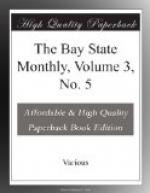Other commanders have fought in ships completely equipped for service by other hands, but Perry had to construct, equip, arm and man his ships, and in person to take two of them in succession into action; and it may be well questioned whether he is not entitled to as much credit for his intelligent comprehension of the wants of the occasion, his energy, and perseverance in collecting the materials to supply those wants, and in making up his fleet, as for his genius and courage in action.
Perry, in the beginning, was unfortunate in having succeeded an officer who, in the engagement was his subordinate in command, and in anticipating a ranking officer in bringing on the conflict; but the surrounding circumstances and the positive orders of the Secretary of the Navy made his meeting the enemy a necessity.
The outcome of the attempts which had been made by the Government for the defence of this section of the country had not been such as to inspire sanguine hopes of the result of this action.
The Adams, the only vessel the United States had upon the Lake before the construction of Perry’s ships, had been captured. General Hull had ignobly surrendered his force to the enemy at the head of the Lake, General Winchester’s army had been lost to the Government, and General Van Rensselaer had been defeated at Niagara.
Perry was to act in conjunction with the northwestern army, under General Harrison, then awaiting the result of the battle to be transported across the Lake, in the event of a victory, to operate against the enemy in his own territory.
Perry’s earnest appeal to Chauncey for men, backed by the promise that if he got them he would acquire honor and glory both for Chauncey and himself, or he would perish in the attempt, should be considered in connection with his appeal to the same officer to bring the men, and take command of the fleet. Together they show that the first appeal was not the result of an ambitious desire for vain glory; no mere impulse of emotion or passion; but the outcome of a high resolve wrought in the laboratory of a noble soul, born of that deliberate purpose which permeated his subsequent conduct in the action and which is recorded in the bronze before us.
The men from the army were animated for a desperate exertion; with them the slaughter at the river Raisin was to be redressed, and its repetition in the northwest was to be made impossible. In this disposition for redress the seamen heartily sympathized, for the war was a contest for Sailors’ Rights. The American Flag then trailed in the dust, but it was to be restored to its appropriate place in the esteem of the men in that section of the country. With a crew animated by these motives, Perry went into action with the Lawrence and fought the enemy almost single-handed until all the guns of his ship were dismounted, and all but eight of her gallant crew that he left on board, were either killed or wounded, when with a boat’s crew he left the Lawrence, boarded and took command of the Niagara, and it is at this moment in the conflict the artist has undertaken to represent him.




